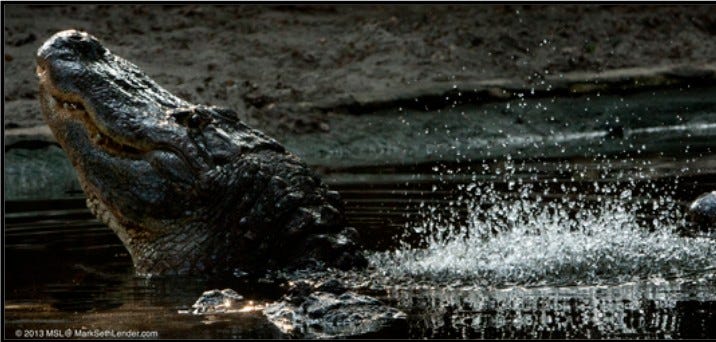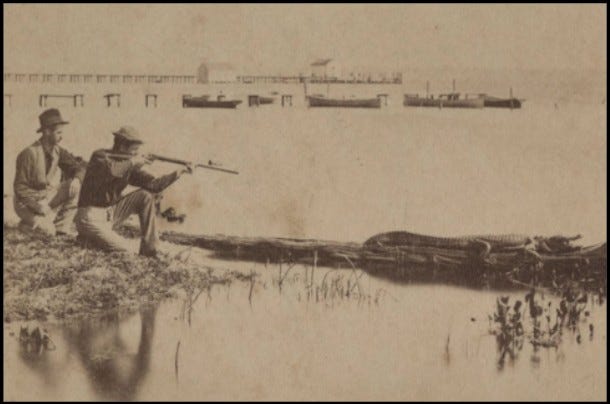Gators Love Tourists—Not!
Bank From the Brink; Could Be Lurking in Every Patch of Water
This story was written by the folks at the Clay County Archives, a service of Clerk of Court and Comptroller Tara S. Green.
After the Civil War, Florida’s exotic flora and fauna caused the state to become a magnet for tourists. They flocked to Northeast Florida, particularly to Green Cove Springs. They came here for the “water cure” provided by the spring and to enjoy the warm winter weather.
Aside from tourists, Florida attracted railroad magnates, artists, photographers, real estate developers, professional game hunters, fisherman, naturalists and the like. While they were here, they participated in the first ecotourism in the state. Everyone wanted to see an alligator, and it was along the St. Johns River that most visitors encountered their first.
The legendary gators were guaranteed to thrill the tourists, their imaginations fueled by the postcards and photos sent from Florida.
Penny postcards, photographs, and stereographs became marketing tools. Here in Green Cove Springs, the best-known local photographer was Isaac Hass. He took an endless amount of photos of the people, plants, animals. springs, steamboats and hotels. Who wouldn’t love mailing a postcard back home to friends in cold, snowy Philadelphia bragging about the sunshine, oranges and gators? Many did just that.
Make way for the king of the swamp, the alligator. Alligator Mississippiensis is its scientific name, and the Seminole word for alligator is “allapattah”. Alligator is an anglicized form of “el lagarto”, which is Spanish for "the lizard".
Alligators fascinated early explorer and naturalist William “Billy” Bartram. He described alligators bellowing at Paynes Prairie near Gainesville:
But what is yet more surprising to a stranger is the incredible loud and terrifying roar, which they are capable of making, especially in the spring season, their breeding time. It most resembles distant thunder, not only shaking the air and waters, but causing the earth to tremble; and when hundreds and thousands are roaring at the same time, you can scarcely be persuaded, but that the whole globe is violently and dangerously agitated.
The end of the Civil War brought with it the commercial exploitation of alligators. Prior to that, they were killed occasionally for sport, but the Seminoles considered them game meat. One hunting party bragged about killing 75 gators. There were no hunting regulations to protect the reptiles, so waste was common and regrettable.
It was no wonder that the Florida alligator grew scarce and by the 1950s were critically endangered. This was mostly due to loss of habitat, pollution, and overhunting. In 1962, Florida stopped the inevitable by outlawing alligator hunting. In 1967, alligators were placed on the endangered species list.
There are a few important laws for visitors to know about gators. You can’t steal their eggs (if you do, you better hope the game warden gets you before momma gator does), feed, trap, injure or keep wild alligators. The unofficial rule every tourist should follow regarding alligators is to assume every body of water, even a shallow ditch, has a gator lurking in it.

In a testament to conservation and best practices, these mighty “swamp kings” made an impressive comeback. They were taken off the endangered species list in 1985 and are now protected. One’s rare legal opportunity to hunt a gator now comes only in the form of the Statewide Alligator Harvest Program.
This is a highly sought after limited entry hunt; there are often more than 15,000 applicants that will apply for approximately 7,000 permits (limit of two gators each).
.



